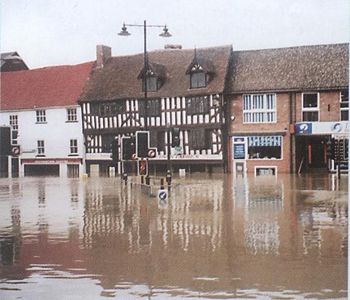Government and insurers say they have come to an agreement that means they can tackle the flood risk insurance dilemma, so even if your home is prone to flooding, you should still be able to insure it. Joanne Atkin explains Hundreds of thousands of households situated in flood risk areas will be able to get […]
 Government and insurers say they have come to an agreement that means they can tackle the flood risk insurance dilemma, so even if your home is prone to flooding, you should still be able to insure it. Joanne Atkin explains
Government and insurers say they have come to an agreement that means they can tackle the flood risk insurance dilemma, so even if your home is prone to flooding, you should still be able to insure it. Joanne Atkin explains
Hundreds of thousands of households situated in flood risk areas will be able to get affordable flood insurance after the government and insurance industry agreed a deal called Flood Re.
This is a massive relief as the Statement of Principles agreement between government and the insurance industry has now come to an end. The agreement was set up in 2000 as a temporary measure and stated that insurers would provide insurance for homes ‘at risk’ of flooding.
But, until now, the government and Association of British Insurers (ABI) could not agree on an answer to the dilemma. This was very worrying because if borrowers cannot get insurance, they will be breaching the terms of their mortgage contract. It could negatively impact on the valuation of the property, the ability to get a mortgage and future saleability affecting both the homeowner and lending organisations.
The British Property Federation (BPF) had warned throughout the process that a solution between insurers and the government must be found as property without insurance is essentially worthless.
Ian Fletcher, director of policy at the BPF, said: “It’s clear that without an agreement with government the insurance market would not be able to offer protection in high risk areas, and with recent flood incidents still fresh in the memory this would have been an unpalatable outcome.”
Flood Re
Although the details of the new agreement have yet to be finalised, it is understood that flood insurance premiums will be capped and linked to council tax bands so that people will know the maximum they will have to pay.
The scheme is called Flood Re and will be funded by a new industry-backed levy which will enable insurance companies to cover those most at risk of flooding. All UK household insurers will have to pay into this not-for-profit pool, creating a fund that can be used to pay claims for people in flood prone areas.
Environment secretary Owen Paterson said: “Flooding is terrible for anyone affected by it. We have worked extremely hard with the industry to reach an agreement on the future of flood insurance. There are still areas to work through but this announcement means that people no longer need to live in fear of being uninsurable and that those at most risk can get protection, now and in the future.”
Otto Thoresen, the ABI’s director general, commented: “Insurers’ priority has always been to ensure that flood insurance remains affordable and available for everyone who needs it. This scheme is the start of a process that aims to deliver affordable flood insurance to high flood risk households.
“Flood Re would be a major undertaking for UK insurers and the work insurers have undertaken to get here reflects the industry’s desire to cover flood risk at an affordable price in the face of the increasing flood threat in the UK. The hard work now begins for both sides if we are to make this vision a reality
“The proposals will be given legal backing through the Water Bill, and will last for at least the next 20 years. Until the Water Bill has passed through Parliament and Flood Re is set up, the industry will continue the current agreement – the Statement of Principles.”
Financing the scheme
Insurance companies will need to pay into the pool an annual charge of £180million.This equates to a levy of £10.50 on annual household premiums but Defra says this represents the estimated level of cross-subsidy that already exists between lower and higher flood risk premiums. This means that householders with insurance policies on properties in low flood risk areas still pay something towards the overall risk.
Insurers will pass the flood risk element from those households deemed at high risk of flooding to the fund. Premiums for the flood risk will be calculated based on council tax banding up to a maximum limit depending on the band.
Environmental data specialist Ground Sure pointed out that not every property will be covered by Flood Re. The firm said: “Homes in the highest Council Tax band H in England, and equivalent properties in Scotland, Wales and Northern Ireland will not be covered by the scheme. Homes built after 1 January 2009 will also not be covered (as applied under the old Flood Insurance Statement of Principles).”
Flood risk areas
Jeremy Blackburn, UK director of external affairs at the Royal Institution of Chartered Surveyors, was disappointed by the news that the Flood Re fund will only be open to those in high flood risk areas.
He explained: “It is quite possible that those living in areas that do not slot directly into this category – but are still at substantial risk – will receive minimal cover, if that. This could prove an enormous problem for those affected and is a big concern.
“It will also take homes out of housing supply by making it much more difficult to get a mortgage, assessed on the insurability of a property. Ministers need to see the connection between this and the housing deficit. That said, it’s been a long, long time in the making but, regardless, Flood Re a step in the right direction.”
Paul Broadhead, head of mortgage policy at the Building Societies Association, welcomed the Flood Re news: ”This new insurance agreement removes uncertainty for hundreds of thousands of consumers by ensuring that affordable flood insurance cover will remain available to those who live in places prone to flooding. It also banishes the spectre of mortgage issues which could have affected mobility and prices in these areas.”
Flood defences
The Department for Environment, Food and Rural Affairs (Defra) has said it will continue to invest in flood defences and has committed to a six-year programme which will provide £370 million of investment in 2015/16 rising with inflation until 2020/21.
Otto Thoresen, the ABI’s director general, said: “The investment means that over 300,000 more households will be better protected by 2021, bringing the overall risk down and helping to secure affordable insurance for people long-term. The government is currently spending £2.3 billion on flood defences meaning that 165,000 homes will be better protected by 2015.”
Simon Douglas, director of AA Insurance, is pleased that flooding remains high on the government’s list of priorities but he is mystified how that would be achieved at a time when Defra has seen a 10 per cent cut in spending, which comes on top of a 29 per cent cut in Defra’s budget during the last spending review, representing a fast-widening funding gap.
Douglas said: “Investment in flood defences and local alleviation schemes makes perfect economic sense. There is no doubt that significant extremes in weather are here to stay. Expert advice, including from the government’s own scientific advisers as well as from the insurance industry, is that Britain must do more to protect its citizens and businesses from costly flood damage, which in turn can bring an instant return on investment when new defences do their job.”
Are you at risk of flooding?
According to the Met Office, 2012 saw the second-highest annual recording of rain fall since 1910 for the UK, while England faced its wettest year to date with extensive flooding across many regions.
The Environment Agency states that 5.2 million properties in England and Wales are at risk of flooding but it’s not just river and coastal flooding that cause problems. There is also surface water and groundwater flooding from excessive rainfall, which is becoming more frequent. This can occur if the ground gets saturated and/or drains and sewers can’t cope with the excessive amount of water.
Mary Dhonau OBE, chief executive of the Know Your Flood Risk campaign and multi-time flood victim, said everyone is at risk of flooding: “Climate change is producing more extreme weather patterns and more intense storm events. The flooding which occurred in Wales last summer, for example, took place in some areas that have not flooded in over 80 years. Flash flooding is the most frequent type of flooding in the UK and it is likely that more properties will be hit by surface water flooding over the next 25 years than by ‘traditional’ river flooding; most of these will be affected for the first time.”
There are ways to find out if your home is at risk of flooding. The Environment Agency’s website has a flood map, which can show the risk to your property of flooding from rivers and sea. Simply enter your postcode. You can also sign up to free flood warnings on its website.
For a more detailed analysis you can go to a specialist search provider and the report will cost around £20 for a residential property. A specialist flood risk consultant can give even more information, such as how often you can expect to flood and from which direction water will come, and that will set you back £200 or more.
The Know Your Flood Risk campaign has a free to download report, “Homeowners guide to flood resilience” packed with useful information including what sort of flood resistance barriers you can put up around your home.
In addition, the Know Your Flood Risk campaign can provide reports specifically about your property for £24.
Useful websites
Know Your Flood Risk – www.knowyourfloodrisk.co.uk
The Environment Agency – www.environment-agency.gov.uk
The Flood Protection Association – www.thefpa.org.uk
The National Flood Forum – www.floodforum.org.uk
Mary Dhonau -www.marydhonau.co.uk













